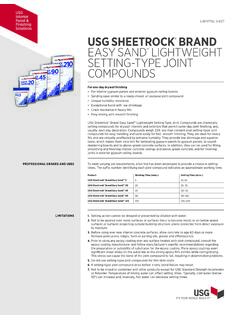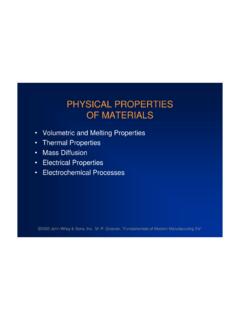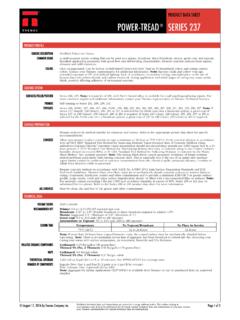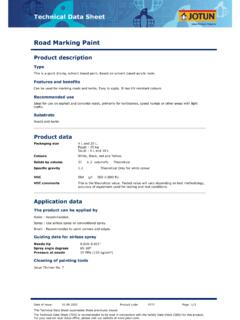Transcription of 9.8.2 Dehydrated Fruits And Vegetables
1 9/95 Food And Agricultural Dehydrated Fruits And General1-2 Dehydration of fruit and Vegetables is one of the oldest forms of food preservation techniquesknown to man and consists primarily of establishments engaged in sun drying or artificially dehydratingfruits and Vegetables . Although food preservation is the primary reason for dehydration, dehydration offruits and Vegetables also lowers the cost of packaging, storing, and transportation by reducing both theweight and volume of the final product. Given the improvement in the quality of Dehydrated foods,along with the increased focus on instant and convenience foods, the potential of Dehydrated Fruits andvegetables is greater than Process Description1-2 Dried or Dehydrated Fruits and Vegetables can be produced by a variety of processes.
2 Theseprocesses differ primarily by the type of drying method used, which depends on the type of food andthe type of characteristics of the final product. In general, dried or Dehydrated Fruits and vegetablesundergo the following process steps: predrying treatments, such as size selection, peeling, and colorpreservation; drying or dehydration, using natural or artificial methods; and postdehydration treatments,such as sweating, inspection, and packaging. Predrying Treatments -Predrying treatments prepare the raw product for drying or dehydration and include rawproduct preparation and color preservation. Raw product preparation includes selection and sorting,washing, peeling (some Fruits and Vegetables ), cutting into the appropriate form, and blanching (forsome Fruits and most Vegetables ).
3 Fruits and Vegetables are selected; sorted according to size, maturity,and soundness; and then washed to remove dust, dirt, insect matter, mold spores, plant parts, and othermaterial that might contaminate or affect the color, aroma, or flavor of the fruit or vegetable . Peelingor removal of any undesirable parts follows washing. The raw product can be peeled by hand(generally not used in the United States due to high labor costs), with lye or alkali solution, with drycaustic and mild abrasion, with steam pressure, with high-pressure washers, or with flame peelers. Forfruits, only apples, pears, bananas, and pineapples are usually peeled before dehydration.
4 Vegetablesnormally peeled include beets, carrots, parsnips, potatoes, onions, and garlic. Prunes and grapes aredipped in an alkali solution to remove the natural waxy surface coating which enhances the dryingprocess. Next, the product is cut into the appropriate shape or form (i. e., halves, wedges, slices, cubes,nuggets, etc.), although some items, such as cherries and corn, may by-pass this operation. Some fruitsand Vegetables are blanched by immersion in hot water (95 to 100C [203 to 212F]) or exposure tosteam. The final step in the predehydration treatment is color preservation, also known as sulfuring. The majority of Fruits are treated with sulfur dioxide (SO) for its antioxidant and preservative effects.
5 2 The presence of SO is very effective in retarding the browning of Fruits , which occurs when the2enzymes are not inactivated by the sufficiently high heat normally used in drying. In addition topreventing browning, SO treatment reduces the destruction of carotene and ascorbic acid, which are2the important nutrients for Fruits . Sulfuring dried Fruits must be closely controlled so that enough sulfuris present to maintain the physical and nutritional properties of the product throughout its expected shelflife, but not so large that it adversely affects flavor. Some Fruits , such as apples, are treated withsolutions of sulfite (sodium sulfite and sodium bisulfite in approximately equal FACTORS9/95proportions) before dehydration.
6 Sulfite solutions are less suitable for Fruits than burning sulfur (SO2gas), however, because the solution penetrates the fruit poorly and can leach natural sugar, flavor, andother components from the dried Fruits commonly use SO gas to prevent browning, this treatment is not practical2for Vegetables . Instead, most Vegetables (potatoes, cabbage, and carrots) are treated with sulfitesolutions to retard enzymatic browning. In addition to color preservation, the presence of a smallamount of sulfite in blanched, cut Vegetables improves storage stability and makes it possible toincrease the drying temperature during dehydration, thus decreasing drying time and increasing thedrier capacity without exceeding the tolerance for heat Or Dehydration -Drying or dehydration is the removal of the majority of water contained in the fruit or vegetableand is the primary stage in the production of Dehydrated Fruits and Vegetables .
7 Several drying methodsare commercially available and the selection of the optimal method is determined by qualityrequirements, raw material characteristics, and economic factors. There are three types of dryingprocesses: sun and solar drying; atmospheric dehydration including stationary or batch processes (kiln,tower, and cabinet driers) and continuous processes (tunnel, continuous belt, belt-trough, fluidized-bed,explosion puffing, foam-mat, spray, drum, and microwave-heated driers); and subatmosphericdehydration (vacuum shelf, vacuum belt, vacuum drum, and freeze driers).Sun drying (used almost exclusively for fruit) and solar drying (used for fruit and Vegetables ) offoods use the power of the sun to remove the moisture from the product.
8 Sun drying of fruit crops islimited to climates with hot sun and dry atmosphere, and to certain Fruits , such as prunes, grapes, dates,figs, apricots, and pears. These crops are processed in substantial quantities without much technical aidby simply spreading the fruit on the ground, racks, trays, or roofs and exposing them to the sun untildry. Advantages of this process are its simplicity and its small capital investment. Disadvantagesinclude complete dependence on the elements and moisture levels no lower than 15 to 20 percent(corresponding to a limited shelf life). Solar drying utilizes black-painted trays, solar trays, collectors,and mirrors to increase solar energy and accelerate forced-air driers artificially dry Fruits and Vegetables by passing heated air withcontrolled relative humidity over the food to be dried, or by passing the food to be dried through theheated air, and is the most widely used method of fruit and vegetable dehydration.
9 Various devices areused to control air circulation and recirculation. Stationary or batch processes include kiln, tower (orstack), and cabinet driers. Continuous processes are used mainly for vegetable dehydration and includetunnel, continuous belt, belt-trough, fluidized-bed, explosion puffing, foam-mat, spray, drum, andmicrowave-heated driers. Tunnel driers are the most flexible, efficient, and widely used dehydrationsystem available (or vacuum) dehydration occurs at low air pressures and includes vacuumshelf, vacuum drum, vacuum belt, and freeze driers. The main purpose of vacuum drying is to enablethe removal of moisture at less than the boiling point under ambient conditions.
10 Because of the highinstallation and operating costs of vacuum driers, this process is used for drying raw material that maydeteriorate as a result of oxidation or may be modified chemically as a result of exposure to air atelevated temperatures. There are two categories of vacuum driers. In the first category, moisture inthe food is evaporated from the liquid to the vapor stage, and includes vacuum shelf, vacuum drum, andvacuum belt driers. In the second category of vacuum driers, the moisture of the food is removed fromthe product by sublimination, which is converting ice directly into water vapor. The advantages offreeze drying are high flavor retention, maximum retention of nutritional value, 9/95 Food And Agricultural damage to the product texture and structure, little change in product shape and color, and afinished product with an open structure that allows fast and complete rehydration.













